
The purple-shot copper is a butterfly in the family of the Lycaenidae or copper butterflies and in the genus of the Lycaena.
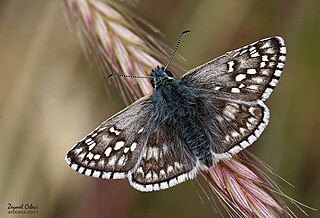
Pyrgus sidae, the yellow-banded skipper, is a species of skipper. It is found from the Iberian Peninsula through southern and eastern Europe, southeast France, the northwestern coastal areas of central Italy, then Istria and the Balkan peninsula, across Turkey, Transcaucasia, to Iran and Afghanistan. East of the Southern Ural Mountains the range extends to northwest Kazakhstan and the west of the Tien Shan in the north.
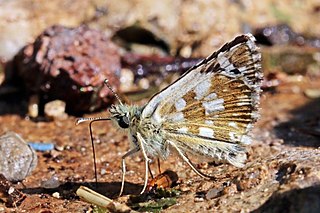
The sandy grizzled skipper is a species of skipper. It has a restricted range in southeastern Europe with a small relict population in central Spain.

Satyrium acaciae, the sloe hairstreak, is a butterfly in the family Lycaenidae.
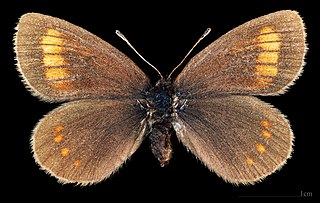
Erebia pharte, the blind ringlet, is a butterfly of the family Nymphalidae. It is an Alpine butterfly.

Melitaea aurelia, or Nickerl's fritillary, is a butterfly of the family Nymphalidae. It is found in central Europe.

Melitaea didyma, the spotted fritillary or red-band fritillary, is a Palearctic butterfly of the family Nymphalidae.

Melitaea phoebe, also known as the knapweed fritillary, is a butterfly of the family Nymphalidae. It is found in the Palearctic realm, including most of Europe and North Africa, excluding the United Kingdom and Scandinavia. Previously, it also included Melitaea telona, which was recently revalidated as a distinct cryptic species.

Leptotes pirithous, commonly known as Lang's short-tailed blue or common zebra blue, is a butterfly of the family Lycaenidae.

Polyommatus amandus, the Amanda's blue, is a butterfly of the family Lycaenidae. It is found in the Palearctic realm.

Pararge xiphioides, the Canary speckled wood, is a butterfly of the family Nymphalidae. It is found in the Canary Islands on La Gomera, La Palma, Tenerife and Gran Canaria.

Agrochola litura, the brown-spot pinion, is a moth of the family Noctuidae. The species was first described by Carl Linnaeus in 1761. It is found in Europe and the Middle East. It is possibly also present in North Africa, but this is unclear because similar looking species Agrochola meridionalis is found there.

Hadula melanopa, the broad-bordered white underwing, is a moth of the family Noctuidae. The species was first described by Carl Peter Thunberg in 1791. Subspecies H. m. melanopa is found in northern Scandinavia; subspecies H. m. rupestralis is found in the Alps, the Balkan Mountains and the Apennine Mountains; subspecies H. m. brunnea is found in mountainous areas of Great Britain and subspecies H. m. koizumidakeana is found in Japan.

Melitaea parthenoides, the meadow fritillary, is a butterfly of the family Nymphalidae. Note that the common name meadow fritillary is also used for the North American species Boloria bellona.

Spialia phlomidis, the Persian skipper, is a butterfly of the family Hesperiidae. It is found in Albania, North Macedonia, Greece, southern Russia, Asia Minor and Iran. The habitat consists of dry steppe habitats at moderate elevations.
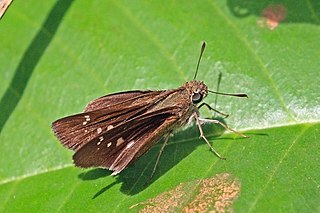
Borbo borbonica, the borbo skipper, Zeller's skipper or olive haired swift, is a butterfly of the family Hesperiidae. It is found along the southern coasts of the Mediterranean Sea including SW Spain, but mainly in Syria, Arabia, Africa, Mauritius and Réunion.
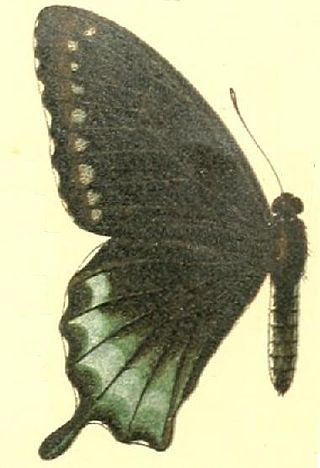
Battus devilliersii is a species of butterfly from the family Papilionidae that is found in Cuba and the Bahamas.
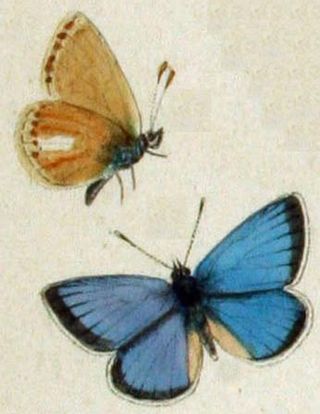
Polyommatus stoliczkanus is a butterfly in the family Lycaenidae. It is found from the western Himalayas to Nepal.

Boeberia is a genus of satyrine butterflies containing a single species Boeberia parmenio found in the Altai Mountains South Siberia, Mongolia, Yakutia, Amur and Northeast China.
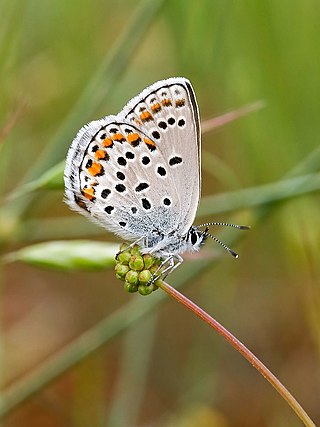
Kretania sephirus, previously known as Plebejus sephirus, is a species of butterfly that belongs to the family Lycaenidae. It is found in Eastern Europe, the Caucasus, and Asia Minor. The species is part of a species complex, with many members of the complex using variations of the name zephyr blue, including pylaon, trappi, and hesperica. The species, which previously belonged to the genus Plebejus, was moved to the genus Kretania following a 2013 molecular phylogenetics study of the subtribe Polyommatina. Many sephirus populations are threatened, and are legally protected in some countries, such as Hungary.




















